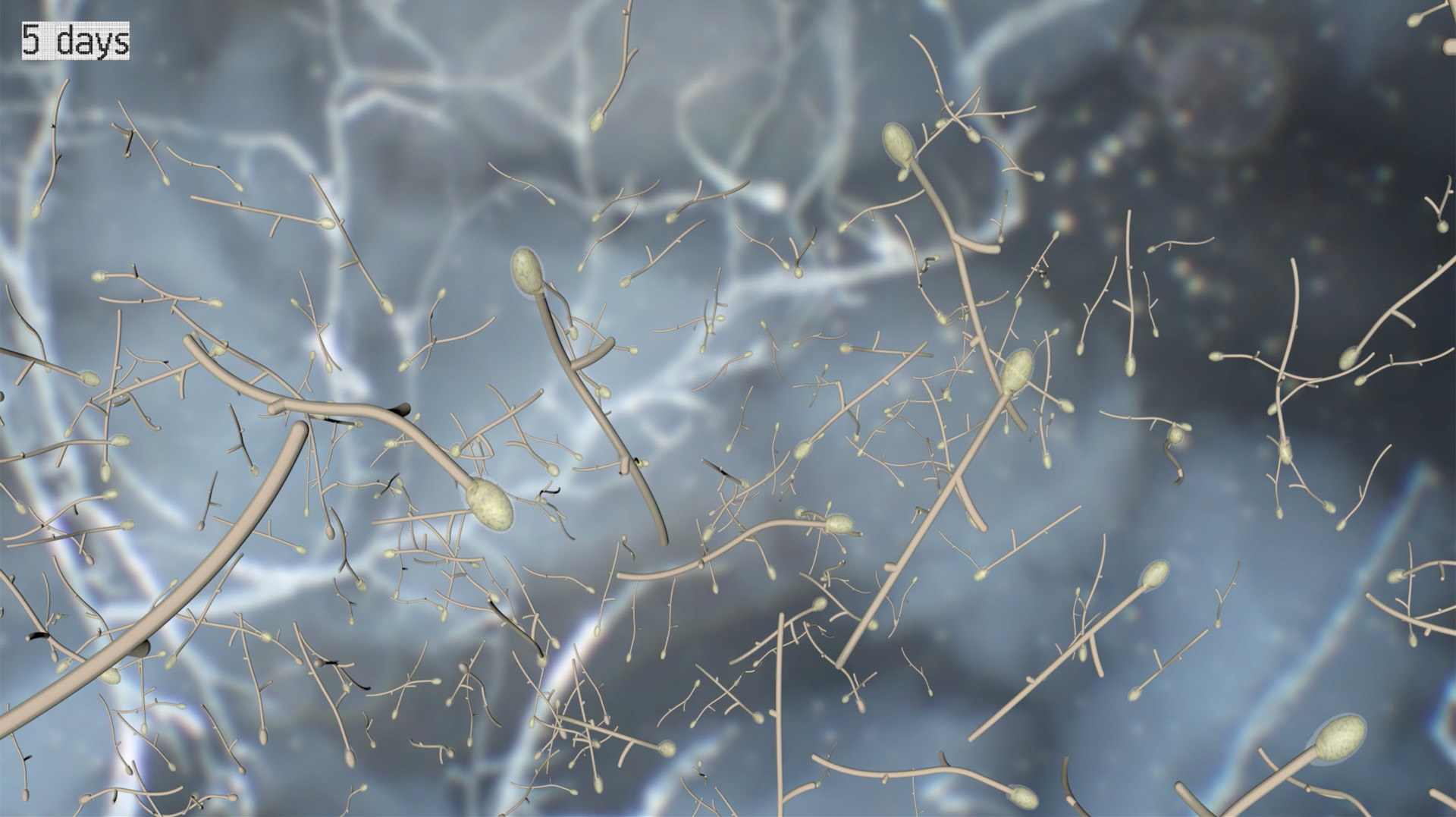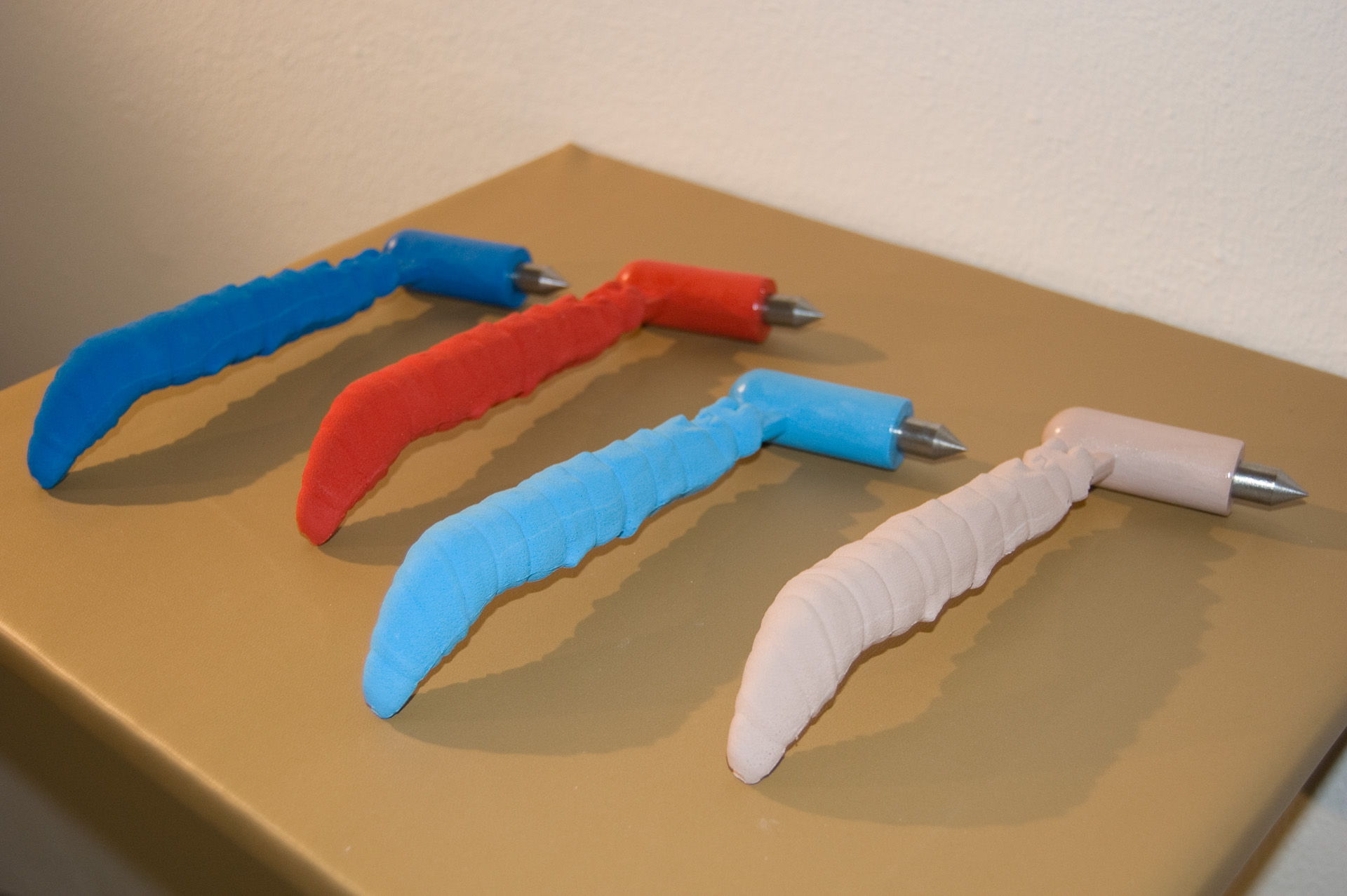Jessica Sehrt (k)
3D Animationen und Simulationen als biologisches Forschungstool
Diplom Gestaltung
Prof. Alex Oppermann
1 November 2018
This work is a composition of microscopic images and the translation of what has been observed in 3D animations. The microscopic images can be found in the backgrounds and textures of the 3D animations. In real terms, this observation is about fungi spore discharge, in particular the subspecies of Basidiomycota. They form a very specific function for spore release, which could only have developed in an evolutionary process over thousands of years and which is based on the very specific form of basidia. These are located in the fungal cap in between the lamellae and are thrust off their site by the accumulation of microscopically small dewdrops. The subterranean hyphae, the network that makes up the actual fungus, then grow from the spores that have been discharged. The hyphae form the mycelium, of which both the roots and the mushroom fruit consist. In the hat of the mushroom fruit, basidia then emerge again from this network, and so the whole procedure basically starts all over again.
The samples observed under the microscope are very transient. What we see here under the microscope will have dried up in two hours, since one has to cut them very thin. One can colour the samples in order to see the structures better, which is how the inspiration came about to colour certain parts of the 3D film in red. All fungi of the Basidiomycota group, which includes the household mushroom, have the structure of the basidia. It is precisely this function that has been visualised in the film. The shapes vary slightly, yet they could represent almost any mushroom. It has been shown that the three-dimensional interpretation of microscopic images in the animation and simulation also raises new questions about how exactly parts behave – which material they are made of, if they can behave or rather deform in any way. Such questions do not necessarily arise when observing the two-dimensional, individual images stemming from research, thus it would seem sensible to go beyond pure visualisation techniques by translating them into moving 3D forms. In this way, the properties of specimens can be viewed in a targeted manner and, as a result, the specimens can be prepared directly according to certain aspects. Since this preparation is very time-consuming and the samples are so temporary, a prior categorisation of the relevant questions in a digital, slightly variable version makes good sense. A rendering PC is actually also an ideal heat incubator for Petri dishes containing fungal mycelia.




Biomimetische Modelle und organismische Metaphern im Werk Tomás Saracenos Prüfer
Diplom Theory
Prof. Dr. Christian Janecke
Die Arbeiten Tomás Saracenos umspannen verschiedene Medien wie Skulptur, Fotografie und Video bis hin zu Architektur und Konstruktionszeichnung. Seine zentralen Arbeiten entfalten sich als betretbare Installationen, die ganze Museumshallen ausfüllen. Ihre organische Formensprache erinnert an verwachsene Zellhaufen, Seifenblasen, Netzstrukturen und Pflanzenfasern. Sie entstehen in einer Auseinandersetzung mit biologischen und physikalischen Erkenntnissen. Befürworter_innen seiner Position rezipieren seine Arbeiten als biomimetische Modelle für eine zukünftige, postfossile Gesellschaft, der es darum geht, der Natur und ihren Formen eine Verwertbarkeit für den Menschen zu entlehnen. Demgegenüber steht die Rezeption seiner Arbeit als eine organismische Metapher dieser zukünftigen Gesellschaft. – Diese Annahmen sollen in der folgenden Arbeit genauer untersucht und hinterfragt werden. Es erfolgt zunächst eine Darstellung und Erläuterung beispielhafter Werke innerhalb der werkseitigen Kontextualisierung des Oeuvres von Seiten des Studio Saraceno selbst und die damit verbundene Einflussnahme auf die Wahrnehmung der Arbeiten als Modelle oder Metaphern. Sollte die konstruktive Modellbildung tatsächlich der vom Künstler angedachte Schwerpunkt sein, wäre die Frage zu beantworten, wohin uns dieses Modell denn überhaupt trägt. Sollte der angedachte Schwerpunkt eher eine metaphorische Darstellung sein, wäre zu beantworten, welche Ideen denn überhaupt hinter diesen Bestrebungen stecken. Abschließend wird untersucht werden, wie tragfähig die Konzepte Modell und Metapher für das diskutierte Oeuvre wirklich sind und wo sie an ihre Grenzen stoßen. Darüber hinaus macht sich die Arbeit zum Ziel in der kreativen Modellbildung an sich mögliche Ideen und Aspekte auszumachen, die für die Idee eines zukünftigen menschlichen Daseins produktiv gemacht werden könnten, aber nur im Falle von Tomás Saracenos Arbeit nicht entwickelt worden sind.
Diplomnebenfach



cv
1984 Geboren in Lich
2005 bis 2010 Studium HfG Offenbach bei Heiner Blum, Ulrike Gabriel
2009 bis 2010 Studium Freie Bildende Kunst Universität der Künste Berlin bei Thomas Zipp
2010 bis 2014 Studium HfBK Städelschule Frankfurt bei Christa Näher und Judith Hopf
2014 Meisterschülerin HfBK Städelschule Frankfurt
2016 bis 2018 Studium HfG Offenbach bei Alexander Oppermann
2018 Diplom HfG Offenbach
2013 bis 2015 Ergänzende Studien Goethe-Universität Frankfurt, Fachbereich Biowissenschaften